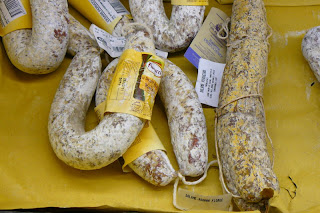Italian meat, a unique treat...
Continuing on my quest to share all things Italian... I thought I'd share the love of carne. Prior to this stay in Italia, I thought of myself as a semi-vegetarian (I will never give up an In-N-Out Burger, however). Things change. Tastes expand. Pig cheek gets eaten. Hmmm.
Traditionally, sheep, pigs and goats, along with rabbits and poultry of all types, have been the principal sources of meat in the Italian diet. Cattle thrive in some areas of the peninsula, particularly in and around the Po Valley. However, they are more often appreciated for their milk, used in making superb cheeses, or as draft animals.
Salumi (a word covering a wide range of salt-cured, air-dried and smoked preparations) is the most common way meat is included in an Italian meal. Most salumi is made from pork in two generic types. The first covers minced meats known as insaccati (encased in protective coverings or sausages). The second covers whole cuts, such as prosciutto (ham), spalla (shoulder), capocollo (neck), pancetta (belly, sometimes smoked as bacon), culatello (an aged filet of rump) and speck (smoked flank). Sources of salumi range beyond pork to beef (for bresaola), goose, goat, boar, chamois, turkey and more.
Veal has always been more popular than beef in much of Italy, not only because of its more delicate flavor and greater tenderness but also because it was often more readily available. Since World War II, beef has played an increasingly important role in the Italian diet. Beef is often imported, largely from other European countries, although Italy boasts some of the finest meat cattle in the world, particularly the Chianina breed, which originated and still flourishes in the central part of Italy and especially Tuscany. © The Italian Trade Commission
On occasion, I will see a meat that is new to me and I'm intrigued: coda alla vaccinara (oxtail); guanciale (cured pork cheek); osso buco (bone hole); pancetta (bacon); pezzetti di cavallo (small pieces of horse); and speck (a distinctively juniper-flavored ham) to name a few.
The one that is on my must try list is Lardo, a unique cured pork product. It is made from the thick layer of fat directly below the skin of a pig; the fat is carefully removed and cured in salt and spices so that it can be stored for extended periods of time. At one point, lardo was treated as the poor man's food in Italy, and it was widely disdained. That opinion has since changed, and lardo is now considered a delicacy by many Italians.
I do draw a line at horse pieces. A semi-vegetarian has to take a stand sometime!
Traditionally, sheep, pigs and goats, along with rabbits and poultry of all types, have been the principal sources of meat in the Italian diet. Cattle thrive in some areas of the peninsula, particularly in and around the Po Valley. However, they are more often appreciated for their milk, used in making superb cheeses, or as draft animals.
Salumi (a word covering a wide range of salt-cured, air-dried and smoked preparations) is the most common way meat is included in an Italian meal. Most salumi is made from pork in two generic types. The first covers minced meats known as insaccati (encased in protective coverings or sausages). The second covers whole cuts, such as prosciutto (ham), spalla (shoulder), capocollo (neck), pancetta (belly, sometimes smoked as bacon), culatello (an aged filet of rump) and speck (smoked flank). Sources of salumi range beyond pork to beef (for bresaola), goose, goat, boar, chamois, turkey and more.
Veal has always been more popular than beef in much of Italy, not only because of its more delicate flavor and greater tenderness but also because it was often more readily available. Since World War II, beef has played an increasingly important role in the Italian diet. Beef is often imported, largely from other European countries, although Italy boasts some of the finest meat cattle in the world, particularly the Chianina breed, which originated and still flourishes in the central part of Italy and especially Tuscany. © The Italian Trade Commission
On occasion, I will see a meat that is new to me and I'm intrigued: coda alla vaccinara (oxtail); guanciale (cured pork cheek); osso buco (bone hole); pancetta (bacon); pezzetti di cavallo (small pieces of horse); and speck (a distinctively juniper-flavored ham) to name a few.
The one that is on my must try list is Lardo, a unique cured pork product. It is made from the thick layer of fat directly below the skin of a pig; the fat is carefully removed and cured in salt and spices so that it can be stored for extended periods of time. At one point, lardo was treated as the poor man's food in Italy, and it was widely disdained. That opinion has since changed, and lardo is now considered a delicacy by many Italians.
I do draw a line at horse pieces. A semi-vegetarian has to take a stand sometime!
Il variar vivenda accresce l'appetito.
Italian to English Translation:
Variety sharpens the appetite.
Italian to English Translation:
Variety sharpens the appetite.



1 comments:
Bone hole, that just sounds wrong! Or maybe my mind is in the gutter...
I will not be joining you on your 'meat and greet (and eat)' endeavor, but I am very happy you are enjoying the tastes of Spoleto.
***
Post a Comment